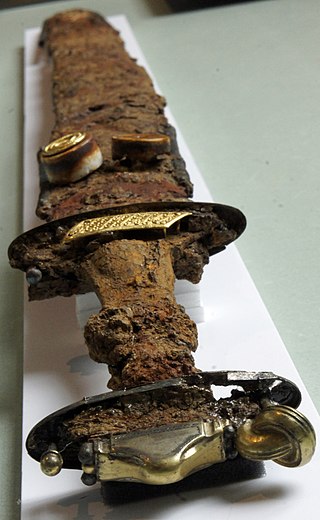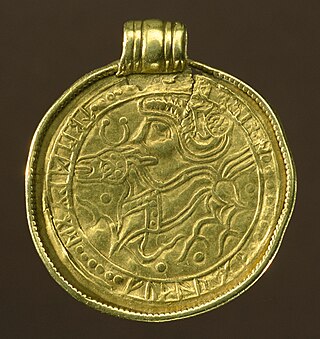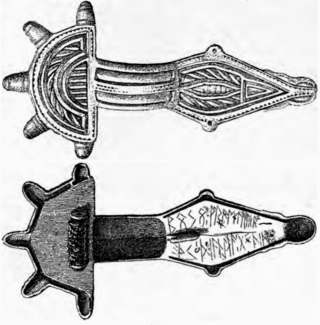Othala, also known as ēðel and odal, is a rune that represents the o and œ phonemes in the Elder Futhark and the Anglo-Saxon Futhorc writing systems respectively. Its name is derived from the reconstructed Proto-Germanic *ōþala- "heritage; inheritance, inherited estate". As it does not occur in Younger Futhark, it disappears from the Scandinavian record around the 8th century, however its usage continued in England into the 11th century.

A rune is a letter in a set of related alphabets known as runic alphabets native to the Germanic peoples. Runes were used to write Germanic languages before they adopted the Latin alphabet, and for specialised purposes thereafter. In addition to representing a sound value, runes can be used to represent the concepts after which they are named (ideographs). Scholars refer to instances of the latter as Begriffsrunen. The Scandinavian variants are also known as fuþark, or futhark, these names derived from the first six letters of the script, ⟨ᚠ⟩, ⟨ᚢ⟩, ⟨ᚦ⟩, ⟨ᚨ⟩/⟨ᚬ⟩, ⟨ᚱ⟩, and ⟨ᚲ⟩/⟨ᚴ⟩, corresponding to the Latin letters ⟨f⟩, ⟨u⟩, ⟨þ⟩/⟨th⟩, ⟨a⟩, ⟨r⟩, and ⟨k⟩. The Anglo-Saxon variant is futhorc, or fuþorc, due to changes in Old English of the sounds represented by the fourth letter, ⟨ᚨ⟩/⟨ᚩ⟩.

The Elder Futhark, also known as the Older Futhark, Old Futhark, or Germanic Futhark, is the oldest form of the runic alphabets. It was a writing system used by Germanic peoples for Northwest Germanic dialects in the Migration Period. Inscriptions are found on artifacts including jewelry, amulets, plateware, tools, and weapons, as well as runestones in Scandinavia, from the 2nd to the 10th centuries.
Algiz is the name conventionally given to the "z-rune" ᛉ of the Elder Futhark runic alphabet. Its transliteration is z, understood as a phoneme of the Proto-Germanic language, the terminal *z continuing Proto-Indo-European terminal *s.
Jera is the conventional name of the j-rune ᛃ of the Elder Futhark, from a reconstructed Common Germanic stem *jēra- meaning "harvest, (good) year".

Anglo-Saxon runes are runes used by the Anglo-Saxons as an alphabet in their native writing system. Today, the characters are known collectively as the futhorc from the sound values of the first six runes. The futhorc was a development from the 24-character Elder Futhark. Since futhorc also recorded Old Frisian along with Old English, the term Anglo-Frisian runes is also used. They were likely to have been used from the 5th century onward.

The Pforzen buckle is a silver belt buckle found in Pforzen, Ostallgäu (Schwaben) in 1992. The Alemannic grave in which it was found dates to the end of the 6th century and was presumably that of a warrior, as it also contained a spear, spatha, seax and shield. The buckle is of the Alemannic Weingarten type.

The Nordendorf fibulae are two mid 6th to early 7th century Alamannic fibulae found in Nordendorf near Augsburg, Bavaria, Germany.

The sequence alu is found in numerous Elder Futhark runic inscriptions of Germanic Iron Age Scandinavia between the 3rd and the 8th century. The word usually appears either alone or as part of an apparent formula. The symbols represent the runes Ansuz, Laguz, and Uruz. The origin and meaning of the word are matters of dispute, though a general agreement exists among scholars that the word represents an instance of historical runic magic or is a metaphor for it. It is the most common of the early runic charm words.
Very few Elder Futhark inscriptions in the Gothic language have been found in the territory historically settled by the Goths. Due to the early Christianization of the Goths, the Gothic alphabet replaced runes by the mid-4th century.

Finds from Vimose, on the island of Funen, Denmark, include some of the oldest datable Elder Futhark runic inscriptions in early Proto-Norse or late Proto-Germanic from the 2nd to 3rd century in the Scandinavian Iron Age and were written in the time of the Roman Empire.

The Bülach fibula is a silver disk-type fibula with almandine inlay found in Bülach, Canton Zürich in 1927. The Alemannic grave in which it was found dates to the 6th century and contained the remains of an adult woman. The fibula, dated by most recent commentators to the latter half of the 6th or early 7th century, bears an Elder Futhark runic inscription, the only one found in Switzerland to date.

The Migration Period sword was a type of sword popular during the Migration Period and the Merovingian period of European history, particularly among the Germanic peoples. It later gave rise to the Carolingian or Viking sword type of the 8th to 11th centuries AD.
The Undley bracteate is a 5th-century bracteate found in Undley Common, near Lakenheath, Suffolk. It bears the earliest known inscription that can be argued to be in Anglo-Frisian Futhorc.

The Meldorf fibula is a Germanic spring-case-type fibula found in Meldorf, Schleswig-Holstein in 1979. Though the exact circumstances of the recovery of the fibula are unknown, it is thought to have come from a cremation grave, probably that of a woman. On typological grounds it has been dated to first half of the 1st century CE, and possibly bears the oldest runic inscription found to date.

The Grumpan bracteate, designated as runic inscription Vg 207 by Rundata, is a gold type C bracteate found in Västergötland, Sweden in 1911. It is dated to the 6th century.
Sowilo (*sōwilō), meaning "sun", is the reconstructed Proto-Germanic language name of the s-rune.

The Frei-Laubersheim fibula is a silver-gilt bow-style fibula found in Frei-Laubersheim, Bad Kreuznach (Rhineland-Palatinate) in 1872. The grave in which it was found dates to approximately the 6th century, and was that of a presumably Frankish woman. The fibula is one of a pair, and bears a runic inscription in the Elder Futhark.

The swastika design is known from artefacts of various cultures since the Neolithic, and it recurs with some frequency on artefacts dated to the Germanic Iron Age, i.e. the Migration period to Viking Age period in Scandinavia, including the Vendel era in Sweden, attested from as early as the 3rd century in Elder Futhark inscriptions and as late as the 9th century on Viking Age image stones.
The Svingerud Runestone is a sandstone object featuring Elder Futhark inscriptions found in a grave west of Oslo, Norway. Radiocarbon dating indicates that the grave and the runestone date to between 1 and 250 CE, during the Roman Iron Age, making it the oldest datable runestone known in the world, and potentially the oldest known runic inscription. The discovery is additionally notable for the content of its inscriptions.













